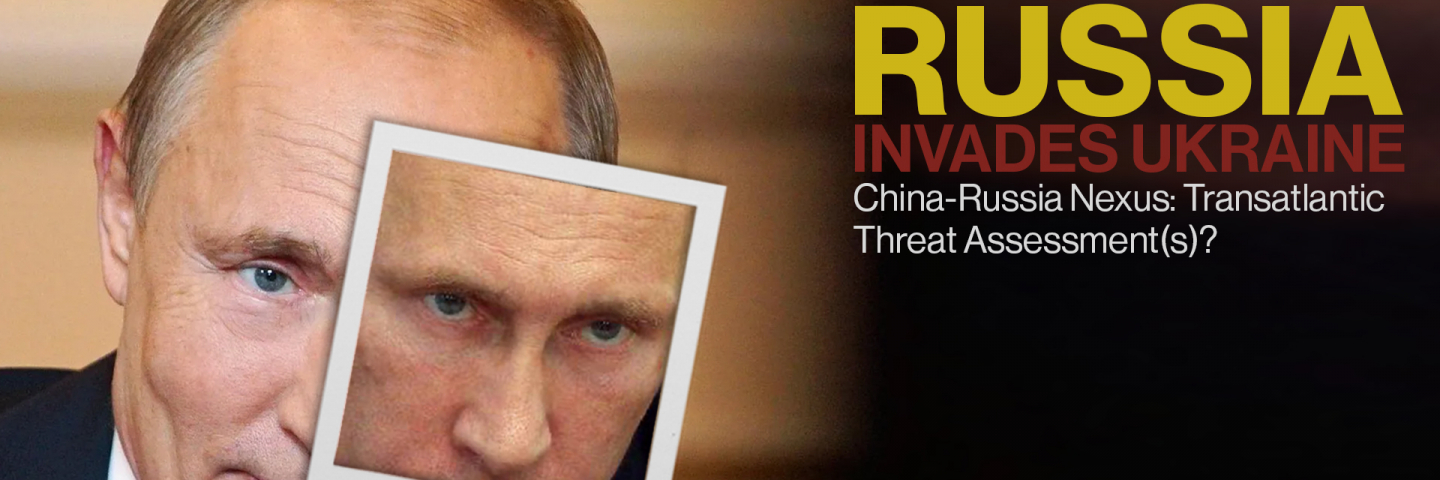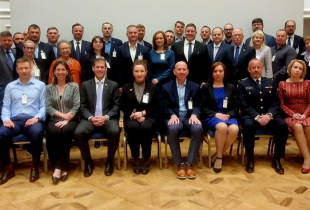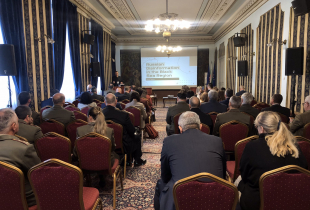
China-Russia Nexus: Transatlantic Threat Assessment(s)?
Introduction
This Russia Seminar Series was held as one of the Sessions of the Strategic Competition Seminar Series Berlin Workshop I held on May 24, 2022.
- Hybrid threats activities as used by Russia and China are designed to 1. undermine democracies and democratic processes, 2. impact on their decision making algorithm and 3. saturate the capacity of the target and the create cascading effects. Such activity seeks to test and exploit vulnerabilities, can be short and long-term, are tailored to different regional contexts and very often leverage and weaponize history.
- In Finland and Sweden the situational awareness of the potential hybrid threats activity from China and Russia in the context of NATO accession is high. One of the reasons for this is that with NATO accession the attitude towards the accession is clear. It is always harder to determine the actual threats to specific national interests. NATO accession and hybrid threats can be understood in terms of three phases:
- 1. Pre-application: given decision making in Stockholm and Helsinki was so quick and the decision to apply so sudden, hybrid threats did not materialize in opposition to this process – Russia and China were rendered reactive;
- 2. Grey zone: the period between application and actual membership provides the greatest opportunity to challenge and discredit membership.
- In Finland, there are multiple ways this could be done and some things have been already detected; cyber and disinformation attacks, attempts to harness those that support the Russia agenda, threats by Russia to withdraw from bilateral projects (waterway); questioning of the Aland Island status as a demilitarized zone and the status of Finnish companies in Russia (this however is connected also to a larger context of the sanctions), and threats of unspecified military consequences on accession. Russian Foreign Ministry spokeswoman Zakharova states that “the Russian military will decide” what those consequences may be. China has reacted negatively but so far hybrid threat activity has not been visible. Previously China has used cyber tools to spy on the Finnish Parliament (trend that seem to have occurred elsewhere as well) and usage of United People’s Front especially it networks related to universities.
- In Sweden the situation is a bit similar; more hybrid threat activity before then this spring; disinformation campaigns have been constant and there is also an example of infiltration into the Swedish Parliament and intelligence services by Russia. Chinese hybrid threat activities in Sweden have been vigorous. It is a larger and more active hybrid threat actor than Russia in Sweden, practicing “wolf warrior” diplomacy, threatening journalists, parliamentarians and experts and raising questions over Chinese investments in Swedish critical national infrastructure.
- 3. Post-accession: probable normalization of hybrid threat activity akin to other NATO member states. Here Finland and Sweden will need to restart relations with Russia from scratch.
- As long as Russia is waging a war in Ukraine its ability to do hybrid threat activity is lower. In the case of Ukraine, early conclusions can be made that Russia’s conventional military attacks from 24 February point to the lack of success of its aim to achieve strategic goals. There is also the question of whether the hybrid threat activity slowed democratization processes but strengthened Ukrainian sense of nationhood.
- Both autocracies and democracies have the same practice of exerting influence over adversaries, however democracies are constrained by democratic practices like rule of law and inability of the state to compel independent media to undertake information operations or private companies to work for the state or individuals to be used to inform. The democratic states have different strategic culture to design influence operations and there is often openly declared aims. Therefore, the hybrid threat activity is what autocracies do against democratic states.
- Russian foreign policy from perhaps as early as 1993, certainly 1995, has sought to attain 3 goals: 1. Russian Great Power status; 2. maintain a sphere of influence in neighboring states; 3. protecting Russia from encroachments from the West. These goals remain the same but Russia’s power has weakened and changed both relative to neighbors and the West. In terms of Russian threat assessment of the West, 3 elements can be identified:
- 1. NATO enlargement: the military dimension involved the proliferation of NATO military infrastructure; the geopolitical threat was encroachment into Russia’s sphere of influence;
- 2. Regime change: this was first perceived as a political threat following the Rose and Orange revolutions of 2003 and 2004, but by 2014 Russian military doctrine identified color revolutions as military threats, highlighting a perception in Moscow that legitimate regimes could be changed via secret plans, external western organization and the export of destabilization/chaos designed to promote anti-Russian hostile states to limit Russian influence and ultimately weaken Russia.
- 3. Negation of Russia’s nuclear deterrent: western missile defense and prompt global strike are designed to eliminate Russia’s nuclear deterrent and Russia discounts U.S. promises these systems are not targeting Russia.
- Role of China in Russian threat perception: Though historically the “China threat” is a feature of Russian strategic culture, this threat perception has dissipated as Russian Far East Military District ground troop deployment in Ukraine attests, though China’s economic threat potential to Russia has increased. Implicitly, while neither threatens the other, there is no expectation of direct mutual military support. Prior to Russia’s invasion of Ukraine, the assumption held that Russia could still, where interests aligned, cooperate with the West or even together build a new international order. This assumption is no longer valid. Russian efforts with China to weaken Western liberal international order and economic dominance are much harder.
GCMC, 27 May 2022.
About the Authors
Dr. Dmitry Gorenburg is Senior Research Scientist in the Strategy, Policy, Plans, and Programs division of the Center for Naval Analysis, where he has worked since 2000. Dr. Gorenburg is an associate at the Harvard University Davis Center for Russian and Eurasian Studies and previously served as Executive Director of the American Association of the Advancement of Slavic Studies (AAASS). His research interests include security issues in the former Soviet Union, Russian military reform, Russian foreign policy, and ethnic politics and identity. He currently serves as the editor of Problems of Post-Communism.
Dr. Graeme P. Herd is a Professor of Transnational Security Studies and Chair of the Research and Policy Analysis Department at the George C. Marshall European Center for Security Studies (GCMC). Dr. Herd runs a monthly Seminar Series which focuses on Russian crisis behavior, the Russia-China nexus, and its the implications for the United States, Germany, friends and allies. Prior to joining the Marshall Center, he was the Professor of International Relations and founding Director of the School of Government, and Associate Dean, Faculty of Business, University of Plymouth, UK (2013-14). Dr. Herd has published eleven books, written over 70 academic papers and delivered over 100 academic and policy-related presentations in 46 countries.
Dr. Hanna Smith is Director of Research and Analysis at the Centre of Excellence for Countering Hybrid Threats. Dr. Smith is an expert on hybrid threats, Russia and Eurasia and Great Power identity, with research interests including security studies, international relations and institutions, as well as regional and Nordic cooperation. Her latest publication is Strategic Culture in Russian Neighbourhood (Lexington 2019) with Katalin Miklossy (eds.). She has published numerous articles in books, academic journals and newspapers, and has taught courses at the University of Helsinki and the University of Eastern Finland. She comments on hybrid threats, Russia and international affairs in both the Finnish and the international media.
The George C. Marshall European Center for Security Studies
The George C. Marshall European Center for Security Studies in Garmisch-Partenkirchen, Germany is a German-American partnership and trusted global network promoting common values and advancing collaborative geostrategic solutions. The Marshall Center’s mission to educate, engage, and empower security partners to collectively affect regional, transnational, and global challenges is achieved through programs designed to promote peaceful, whole of government approaches to address today’s most pressing security challenges. Since its creation in 1992, the Marshall Center’s alumni network has grown to include over 15,000 professionals from 157 countries. More information on the Marshall Center can be found online at www.marshallcenter.org.
The Clock Tower Security Series provides short summaries of Seminar Series hosted by the George C. Marshall European Center for Security Studies. These summaries capture key analytical points from the events and serve as a useful tool for policy makers, practitioners, and academics.
The articles in this seminar series reflect the views of the authors and are not necessarily the official policy of the United States, Germany, or any other governments.

